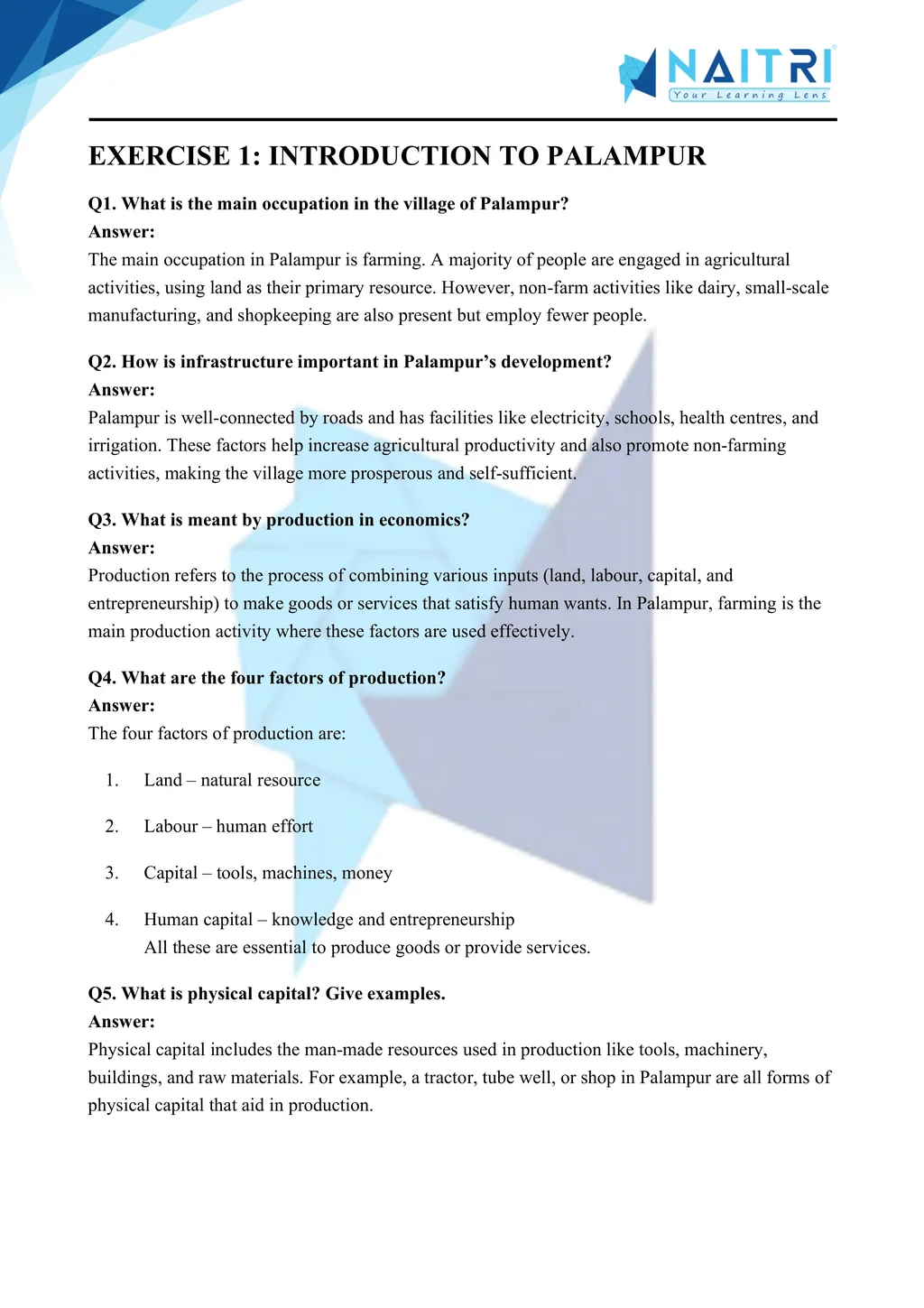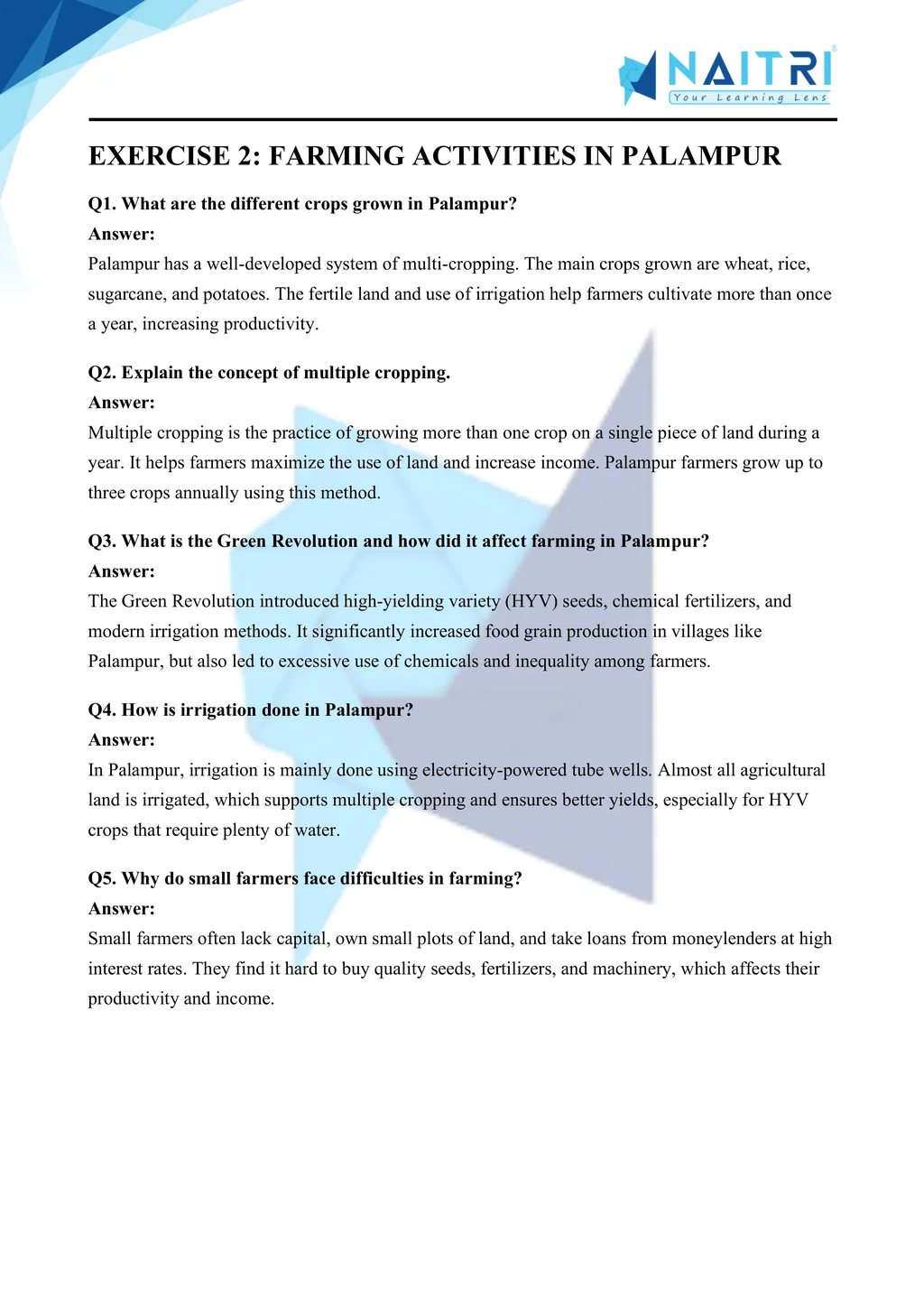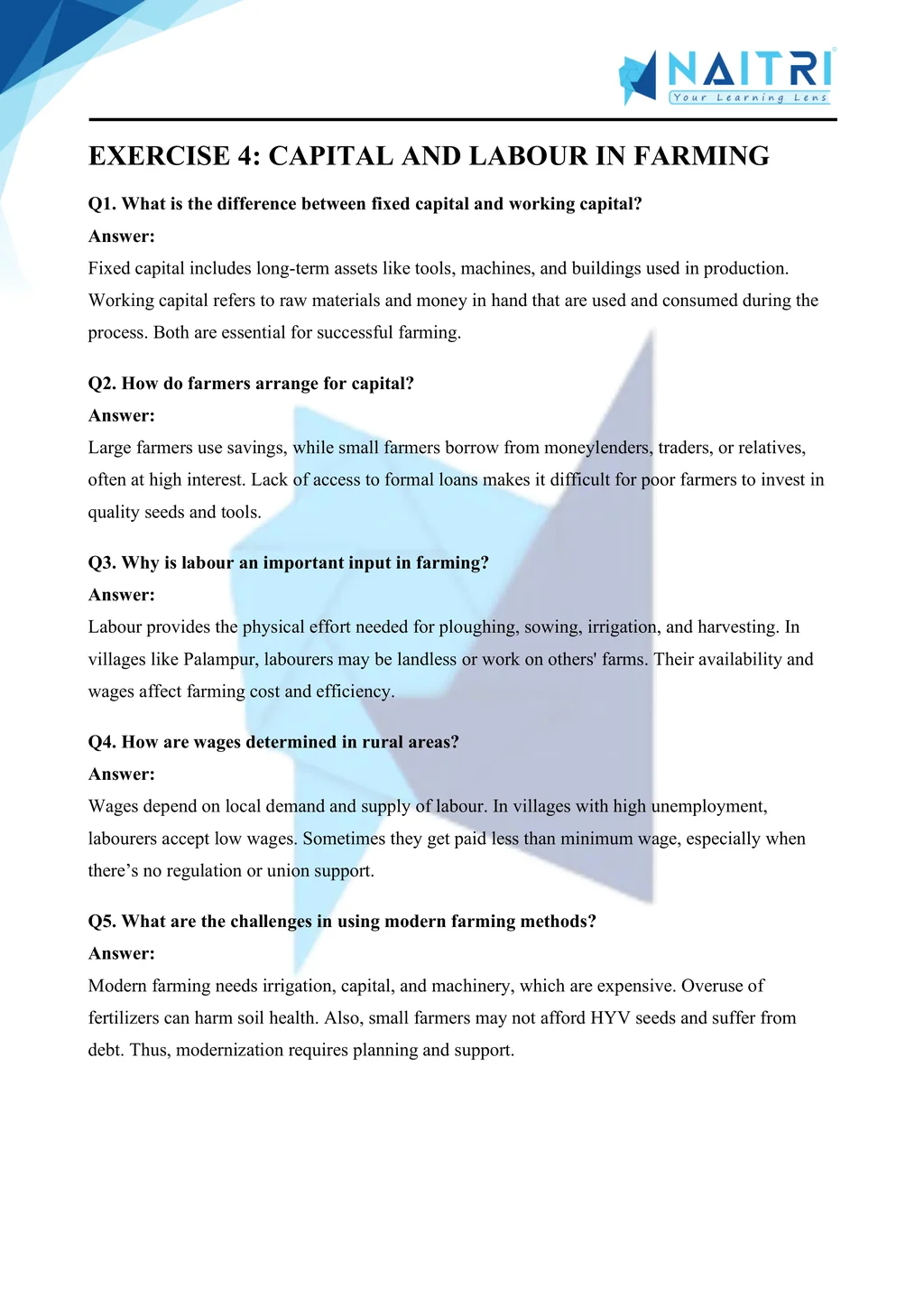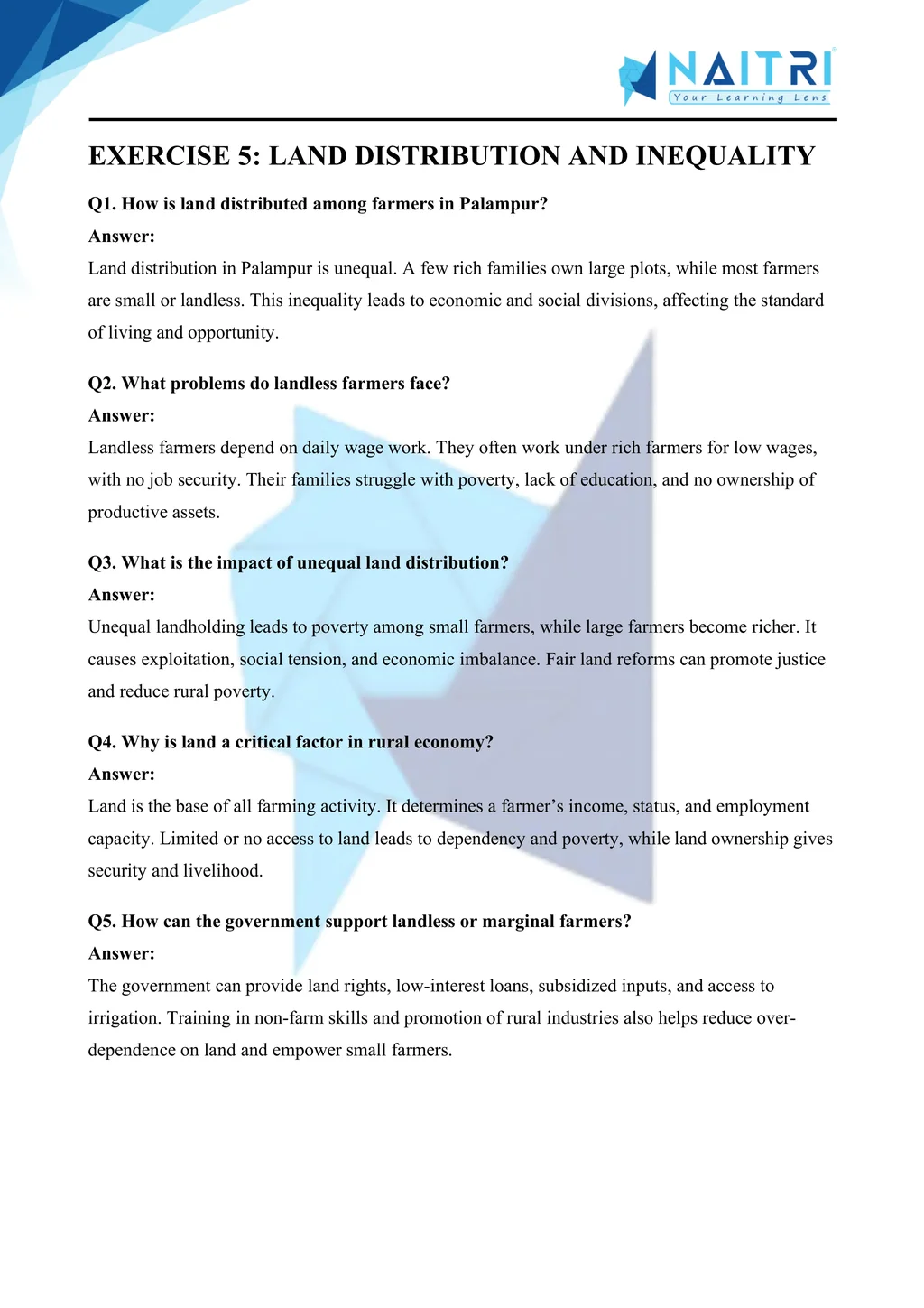MP Board Solutions for Class 9 Economics Chapter 1 – The Story of Village Palampur
MP Board Solutions for Class 9 Economics Chapter 1 – The Story of Village Palampur are essential for understanding how production activities shape the rural economy, as per the MPBSE curriculum. These well-structured answers help students grasp topics like the use of land, labour, capital, and the distinction between farming and non-farming activities. Designed according to the latest syllabus, these solutions strengthen conceptual clarity and improve exam preparation. Ideal for revision and practice, they develop basic economic understanding, making them a valuable study tool for scoring well in Class 9 Social Science exams.
MP Board Solutions For Class 9 Economics – The Story of Village Palampur – Exercise Images





Experience Economics Like Never Before – With AR!
Understanding The Story of Village Palampur is now more exciting and immersive! With the NAITRI App, you can explore complex economics concepts through Augmented Reality (AR). See farms operate, labor divide, and rural production unfold — right in front of you. Our AR-powered lessons make learning interactive, 3D, and fun, helping you retain concepts better and enjoy every topic.



Visualize . Interact . Understand . The future of learning is here
The Story of Village Palampur – Important Questions with Answers
What is the main production activity in Palampur?
Answer: The main activity in Palampur is farming, where most people are engaged in agriculture, using land, labor, capital, and modern tools for crop production.Name the four factors of production.
Answer: The four factors are land, labour, physical capital (tools, machines), and human capital (knowledge and enterprise) required for all types of production activities.What is the difference between fixed and working capital?
Answer: Fixed capital includes tools, machines, and buildings used for years, while working capital includes money and raw materials used in daily operations.Why is land considered a scarce factor of production in Palampur?
Answer: Land is limited in Palampur. All cultivable land is already used, and the population is increasing, making land scarcity a significant issue.How has electricity changed the system of irrigation in Palampur?
Answer: Electricity has helped in the use of electric tube wells, improving irrigation, increasing crop yield, and enabling multiple cropping systems.What is multiple cropping?
Answer: Multiple cropping is the practice of growing more than one crop on the same land during a year, which helps in maximizing productivity.What is the difference between multiple cropping and modern farming methods?
Answer: Multiple cropping means growing more than one crop, while modern farming uses HYV seeds, chemical fertilizers, pesticides, and machinery for higher yield.How do small farmers arrange capital for farming?
Answer: Small farmers borrow money from moneylenders, relatives, or traders, often at high interest rates, putting them under financial pressure.Why do small farmers face difficulties in modern farming?
Answer: Due to lack of capital, small land size, and dependence on informal loans, they can’t afford expensive inputs, machinery, or irrigation systems.What is physical capital?
Answer: Physical capital refers to the man-made inputs used in production like tools, machines, buildings, and raw materials.What is human capital?
Answer: Human capital includes skills, education, and health of people that increase their ability to produce efficiently and contribute to the economy.Who are farm laborers?
Answer: Farm laborers are landless or small landholders who work on others’ farms for wages. They often earn low incomes and have no job security.What non-farming activities are carried out in Palampur?
Answer: Activities like dairy, small-scale manufacturing, shopkeeping, and transport services provide employment outside agriculture.What is the role of dairy in Palampur’s economy?
Answer: Dairy is an important non-farm activity where people rear buffaloes and sell milk to nearby towns, generating supplementary income.How is transport a part of Palampur’s economic life?
Answer: Transport services like rickshaws, tractors, jeeps, and trucks help in moving goods and people, contributing to trade and mobility.What are the challenges of non-farming activities in villages?
Answer: Non-farm activities face issues like lack of capital, poor infrastructure, limited market access, and low support from formal institutions.How can small farmers be supported?
Answer: Providing low-interest loans, technical support, better seeds, irrigation, and access to government schemes can help small farmers improve production.Why is education important for rural development?
Answer: Education improves human capital, enhances farming and non-farming skills, increases employment opportunities, and helps people adopt new technologies.How do large farmers use surplus production?
Answer: Large farmers sell surplus crops in the market, earn profits, and reinvest in improving farming techniques or non-farming businesses.How are village markets important for the economy?
Answer: Local markets provide space for buying and selling agricultural and dairy products, tools, and daily items, supporting economic activities.What is the impact of HYV seeds in farming?
Answer: HYV seeds increase crop yield but require more water, fertilizers, and pesticides. While they raise income, they also increase input costs.What are the environmental effects of modern farming?
Answer: Overuse of chemical fertilizers and pesticides leads to soil degradation, pollution, and loss of biodiversity in the long term.Why is modern farming capital-intensive?
Answer: It requires heavy investment in HYV seeds, irrigation, machinery, and fertilizers, making it difficult for poor or marginal farmers to afford.What is the main drawback of relying on informal credit sources?
Answer: Informal lenders charge high interest, often trap borrowers in debt cycles, and have no legal accountability or formal repayment structures.Summarize the key learnings from Palampur’s model.
Answer: Palampur shows how combining modern agriculture, non-farming activities, access to capital, and infrastructure can lead to rural development and improved livelihoods.
The Story of Village Palampur introduces basic economic concepts through a fictional village. It highlights how land, labor, physical capital, and human capital are used to produce goods and services. Students learn about farming practices, types of crops, non-farming activities, and the role of transport. This chapter helps build an understanding of the rural economy and the interdependence of resources, laying the foundation for economic thinking.
Related Chapters You May Like
Download Naitri App
Easy, Visual Learning — Right on Your Phone
Learn with Augmented Reality! The Naitri app makes CBSE and MP Board concepts interactive and fun — even in low-resource settings. Watch lessons, complete homework, take tests, and track progress — all in one place. Anytime. Anywhere.
Available on








